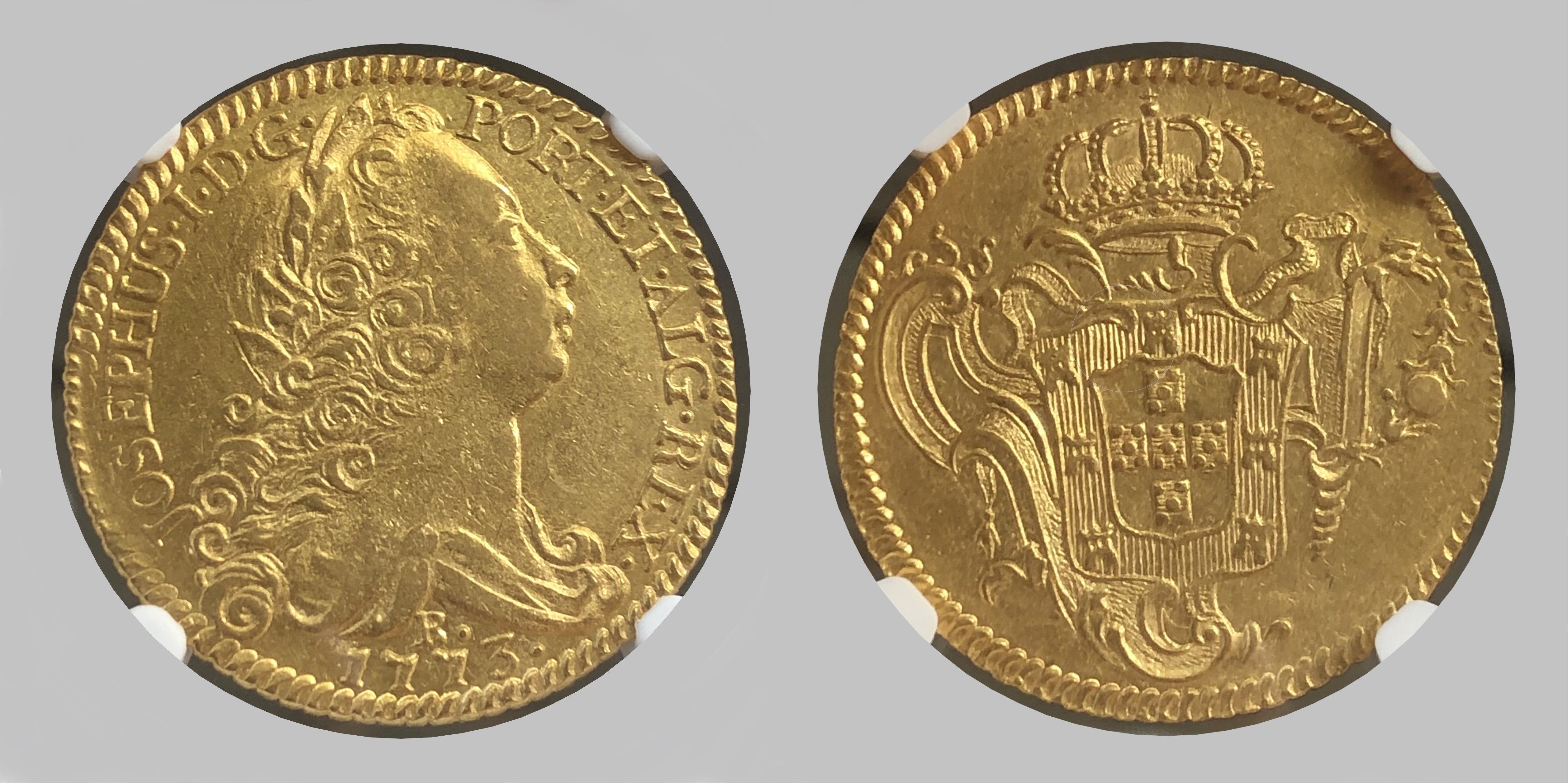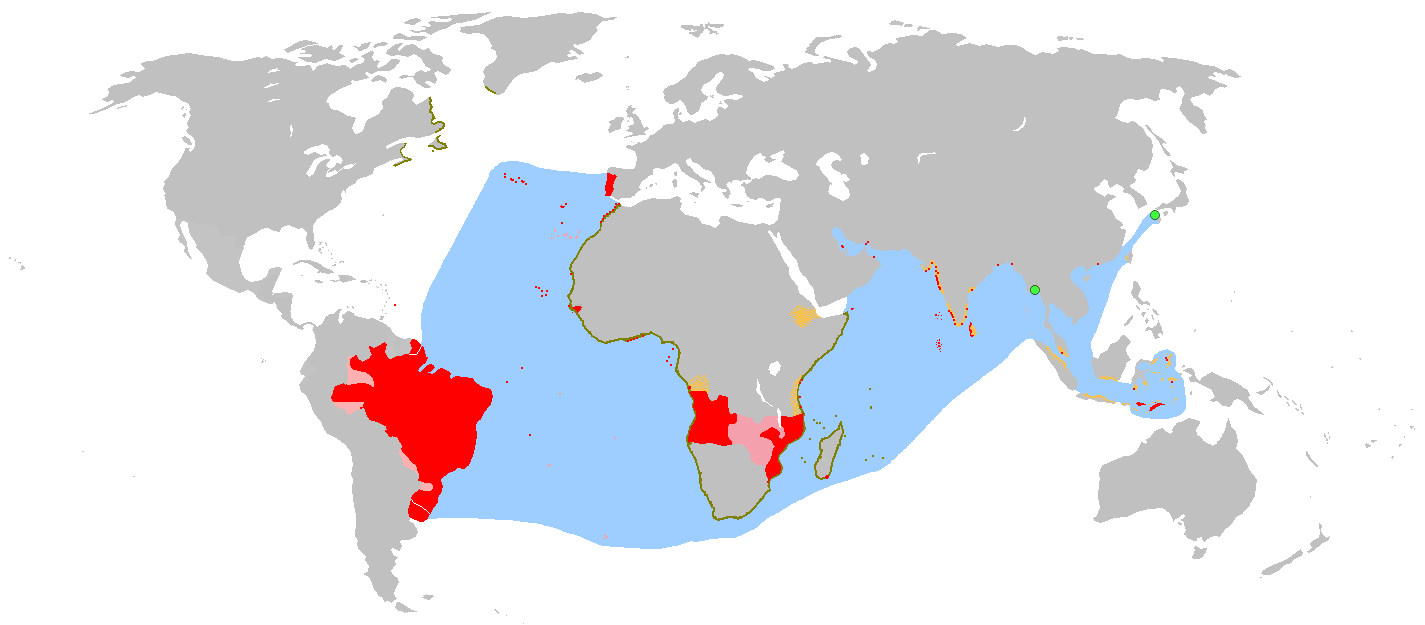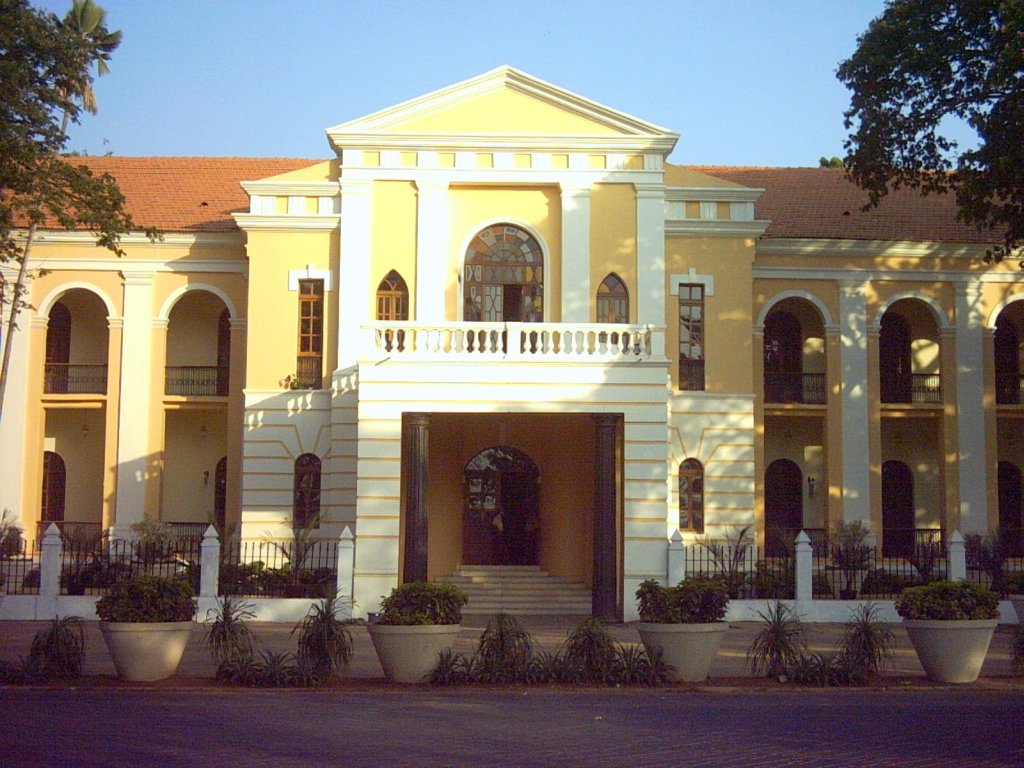|
Fort Of São Tiago Of Banastarim (Goa)
, partof = Portuguese Goa , location = Velha Goa, Goa, India , image = , caption = , map_type = India Goa , map_size = 300 , map_alt = , map_caption = Banastarim India , type = , coordinates = , code = IN-GA , built = 1635-1681 , builder = Portuguese India , materials = Brick and Stone fort , height = , used = , demolished = Abandoned , condition = Ruins , ownership = Government of India , open_to_public = Yes , controlledby = (1512-1961)Bijapur Sultanate (1512-1513) (1961-) , garrison = , current_commander = , commanders = , occupants = , battles = , events = , image2 = , caption2 = The Fort of São Tiago of Banastarim in India, also known as Fort St. James Banastarim or Benastari Castle, is located at on the right bank of Cumbarjua Canal, on the eastern tip of Old Goa, North Goa district in the state of Goa on the west coast of India. History Erected by the local rulers, this fort was conquered by the Viceroy of Portuguese India Afonso de Albuquerque on 2 A ... [...More Info...] [...Related Items...] OR: [Wikipedia] [Google] [Baidu] |
Portuguese Goa
Old Goa ( Konkani: ; pt, Velha Goa, translation='Old Goa') is a historical site and city situated on the southern banks of the River Mandovi, within the Tiswadi ''taluka'' (''Ilhas'') of North Goa district, in the Indian state of Goa. The city was established by the Bijapur Sultanate in the 15th century AD. After the Portuguese conquest of Goa, it served as capital of Portuguese Indian possessions, such as Mumbai/ Bombay ('' Bom Bahia'') territory and the state of Kochi/ Cochin ('' Cochim''), until its abandonment in the 18th century AD due to a plague. Under Portuguese rule, it is said to have been a city of nearly 200,000 people, from whence the spice trade was carried out across the Portuguese East Indies. The deserted city has been declared a World Heritage Site by the UNESCO. Old Goa is approximately east of the current state capital of Panjim ( pt, Nova Goa, translation='New Goa'). Etymology The name "Old Goa" was first used in the 1960s in the address of the Konkan ... [...More Info...] [...Related Items...] OR: [Wikipedia] [Google] [Baidu] |
Jose I Of Portugal
Dom Joseph I ( pt, José Francisco António Inácio Norberto Agostinho, ; 6 June 1714 – 24 February 1777), known as the Reformer (Portuguese: ''o Reformador''), was King of Portugal from 31 July 1750 until his death in 1777. Among other activities, Joseph was devoted to hunting and the opera. Indeed, he assembled one of the greatest collections of operatic scores in Europe. His government was controlled by Sebastião José de Carvalho e Melo, 1st Marquis of Pombal. The third child and second son of King Dom John V, Joseph became his father's heir as an infant when his older brother, Dom Pedro, Prince of Brazil, died. In 1729 he married Infanta Mariana Victoria, the eldest daughter of King Don Philip V of Spain, and Joseph's sister Infanta Barbara married Mariana Victoria's half-brother Prince Don Ferdinand (the future King Don Ferdinand VI of Spain). These marriages were known as the Exchange of the Princesses. Joseph and Mariana Victoria had four daughters. With the deat ... [...More Info...] [...Related Items...] OR: [Wikipedia] [Google] [Baidu] |
Portuguese Forts
This article will list all fortifications that were built, partially built, or ordered to be built by the Portuguese throughout the globe. All forts in this list are outside the modern territory of Portugal, and were built for the purpose of colonialism and the Portuguese Overseas Empire. Portuguese explorers have discovered many lands and the sea routes in the 15th-18th centuries during the Age of Discovery. Along the way they built outposts and fortresses, many of which still exist today all over the world. Similar in design they are often easy to recognize although not in Portuguese hands for many years or centuries already. List of forts by continent Africa Americas Asia and Oceania See also * Architecture of Portugal Portuguese architecture refers to both the architecture of Portugal's modern-day territory in Continental Portugal, the Azores and Madeira, as well as the architectural heritage/patrimony of Portuguese architects and styles throughout the world, .. ... [...More Info...] [...Related Items...] OR: [Wikipedia] [Google] [Baidu] |
Portuguese Empire
The Portuguese Empire ( pt, Império Português), also known as the Portuguese Overseas (''Ultramar Português'') or the Portuguese Colonial Empire (''Império Colonial Português''), was composed of the overseas colonies, factories, and the later overseas territories governed by Portugal. It was one of the longest-lived empires in European history, lasting almost six centuries from the conquest of Ceuta in North Africa, in 1415, to the transfer of sovereignty over Macau to China in 1999. The empire began in the 15th century, and from the early 16th century it stretched across the globe, with bases in North and South America, Africa, and various regions of Asia and Oceania. The Portuguese Empire originated at the beginning of the Age of Discovery, and the power and influence of the Kingdom of Portugal would eventually expand across the globe. In the wake of the Reconquista, Portuguese sailors began exploring the coast of Africa and the Atlantic archipelagos in 1418–1419, u ... [...More Info...] [...Related Items...] OR: [Wikipedia] [Google] [Baidu] |
Asian Educational Services
Asian Educational Services (AES) is a New Delhi, India-based publishing house that specialises in antiquarian reprints of books that were originally published between the 17th and early 20th centuries. Founded by Jagdish Lall Jetley in 1973, the selection of titles are over 1200 in number. Involvement This firm has a very active publication programme that aims to preserve knowledge, in the form of old books, from being lost. An extensive list of about 200 travelogues gives a vivid picture of India specifically, and Asia generally. Many of the big names in Asian exploration and in the field of history have been reprinted. W. W. Hunter, H. H. Wilson, Max Muller, Rhys Davids, H. H. Risley, Edgar Thurston, G. Forrest, G. B. Malleson, Nicholas Greenwood, William Muir, Vincent A. Smith, Emerson Tennent, Wilhelm Geiger, Monier-Willams, Sven Hedin, Richard F. Burton, Francis Younghusband, William Moorcroft, M. Auriel Stein, Marco Polo, Heuin Tsang, Al-Beruni, William of ... [...More Info...] [...Related Items...] OR: [Wikipedia] [Google] [Baidu] |
Pangim
Panaji (; also known as Panjim) is the capital of the Indian state of Goa and the headquarters of North Goa district. Previously, it was the territorial capital of the former Portuguese India. It lies on the banks of the Mandovi river estuary in the Tiswadi sub-district ''(tehsil)''. With a population of 114,759 in the metropolitan area, Panaji is Goa's largest urban agglomeration, ahead of Margao and Mormugao. Panaji has terraced hills, concrete buildings with balconies and red-tiled roofs, churches, and a riverside promenade. There are avenues lined with gulmohar, acacia and other trees. The baroque Our Lady of the Immaculate Conception Church is located overlooking the main square known as Praça da Igreja. Panaji has been selected as one of hundred Indian cities to be developed as a smart city under the Smart Cities Mission. The city was built with stepped streets and a seven kilometre long promenade on a planned grid system after the Portuguese relocated the capital f ... [...More Info...] [...Related Items...] OR: [Wikipedia] [Google] [Baidu] |
Primate Of The East
The Titular Patriarch of the East Indies ( la, Patriarcha Indiarum Orientalium; for Titular Patriarchate of the East Indies) in the Catholic hierarchy is the title of the Archbishop of Goa and Daman in India; another of his titles is the Primate of the East. Unlike the patriarchs and the major archbishops of the Eastern Catholic Churches ''sui juris'', the Patriarch of the East Indies is within the Latin Church similar to the residential Latin Patriarchs of Venice, Lisbon and Jerusalem, enjoying only an honorary position. Like the Patriarch of the West Indies, the Patriarch of the East Indies is a titular patriarchate unlike the residential Latin Catholic Patriarchs. The title is attached to the Archbishop of Goa and Daman, the diocesan ordinary of the Archdiocese of Goa and Daman and the metropolitan archbishop of the Province of Goa and Daman. This title of Patriarch or Primate of the East Indies was conferred upon the Archbishop of Goa as a result of a concordat between the ... [...More Info...] [...Related Items...] OR: [Wikipedia] [Google] [Baidu] |
Bartizans
A bartizan (an alteration of ''bratticing''), also called a guerite, ''garita'', or ''échauguette'', or spelled bartisan, is an overhanging, wall-mounted turret projecting from the walls of late medieval and early-modern fortifications from the early 14th century up to the 18th century. Most frequently found at corners, they protected a warder and enabled him to see his surroundings. Bartizans generally are furnished with oillets or arrow slits. The turret was usually supported by stepped masonry corbels and could be round, polygonal or square. Bartizans were incorporated into many notable examples of Scottish Baronial architecture. In the architecture of Aberdeen, the new Town House, built in 1868–74, incorporates bartizans in the West Tower. Gallery At walls File:Round Bartizan, Fortaleza de Santiago, Sesimbra, Portugal.JPG, ''Guarita'' at Fortaleza de Santiago, Sesimbra Municipality, Portugal. File:Sudika Isla watchtower.jpg, ''Gardjola'' at the Spur, Senglea, Malta ... [...More Info...] [...Related Items...] OR: [Wikipedia] [Google] [Baidu] |
Barbican
A barbican (from fro, barbacane) is a fortified outpost or fortified gateway, such as at an outer fortifications, defense perimeter of a city or castle, or any tower situated over a gate or bridge which was used for defensive purposes. Europe In the Middle Ages, barbicans were typically situated outside the main line of defenses, and were connected to the Defensive wall, city walls with a walled road called ''the neck''. In the 15th century, with the improvement in siege tactics and artillery, barbicans lost their significance. Barbicans were built well into the 16th century. Fortified or mock-fortified gatehouses remained a feature of ambitious French and English residences well into the 17th century. Portuguese medieval fortification nomenclature uses barbican to describe any wall outside of and lower than the main defensive wall that forms a second barrier. The barrier may be complete, extensive or only protect particularly weak areas. The more restrictive term ''gate barb ... [...More Info...] [...Related Items...] OR: [Wikipedia] [Google] [Baidu] |
Tomás Fernandes
{{disambiguation ...
Tomás may refer to: * Tomás (given name) * Tomás (surname) Tomás is a Spanish and Portuguese surname, equivalent of ''Thomas''. It may refer to: * Antonio Tomás (born 1985), professional Spanish footballer * Belarmino Tomás (1892–1950), Asturian trade unionist and socialist politician * Fray Tomás ... [...More Info...] [...Related Items...] OR: [Wikipedia] [Google] [Baidu] |
Moors
The term Moor, derived from the ancient Mauri, is an exonym first used by Christian Europeans to designate the Muslim inhabitants of the Maghreb, the Iberian Peninsula, Sicily and Malta during the Middle Ages. Moors are not a distinct or self-defined people. The 1911 ''Encyclopædia Britannica'' observed that the term had "no real ethnological value." Europeans of the Middle Ages and the early modern period variously applied the name to Arabs and North African Berbers, as well as Muslim Europeans. The term has also been used in Europe in a broader, somewhat derogatory sense to refer to Muslims in general,Menocal, María Rosa (2002). ''Ornament of the World: How Muslims, Jews and Christians Created a Culture of Tolerance in Medieval Spain''. Little, Brown, & Co. , p. 241 especially those of Arab or Berber descent, whether living in Spain or North Africa. During the colonial era, the Portuguese introduced the names " Ceylon Moors" and "Indian Moors" in South Asia and Sri ... [...More Info...] [...Related Items...] OR: [Wikipedia] [Google] [Baidu] |
Arsenal
An arsenal is a place where arms and ammunition are made, maintained and repaired, stored, or issued, in any combination, whether privately or publicly owned. Arsenal and armoury (British English) or armory (American English) are mostly regarded as synonyms, although subtle differences in usage exist. A sub-armory is a place of temporary storage or carrying of weapons and ammunition, such as any temporary post or patrol vehicle that is only operational in certain times of the day. Etymology The term in English entered the language in the 16th century as a loanword from french: arsenal, itself deriving from the it, arsenale, which in turn is thought to be a corruption of ar, دار الصناعة, , meaning "manufacturing shop". Types A lower-class arsenal, which can furnish the materiel and equipment of a small army, may contain a laboratory, gun and carriage factories, small-arms ammunition, small-arms, harness, saddlery tent and powder factories; in addition, it mu ... [...More Info...] [...Related Items...] OR: [Wikipedia] [Google] [Baidu] |




.jpg)


